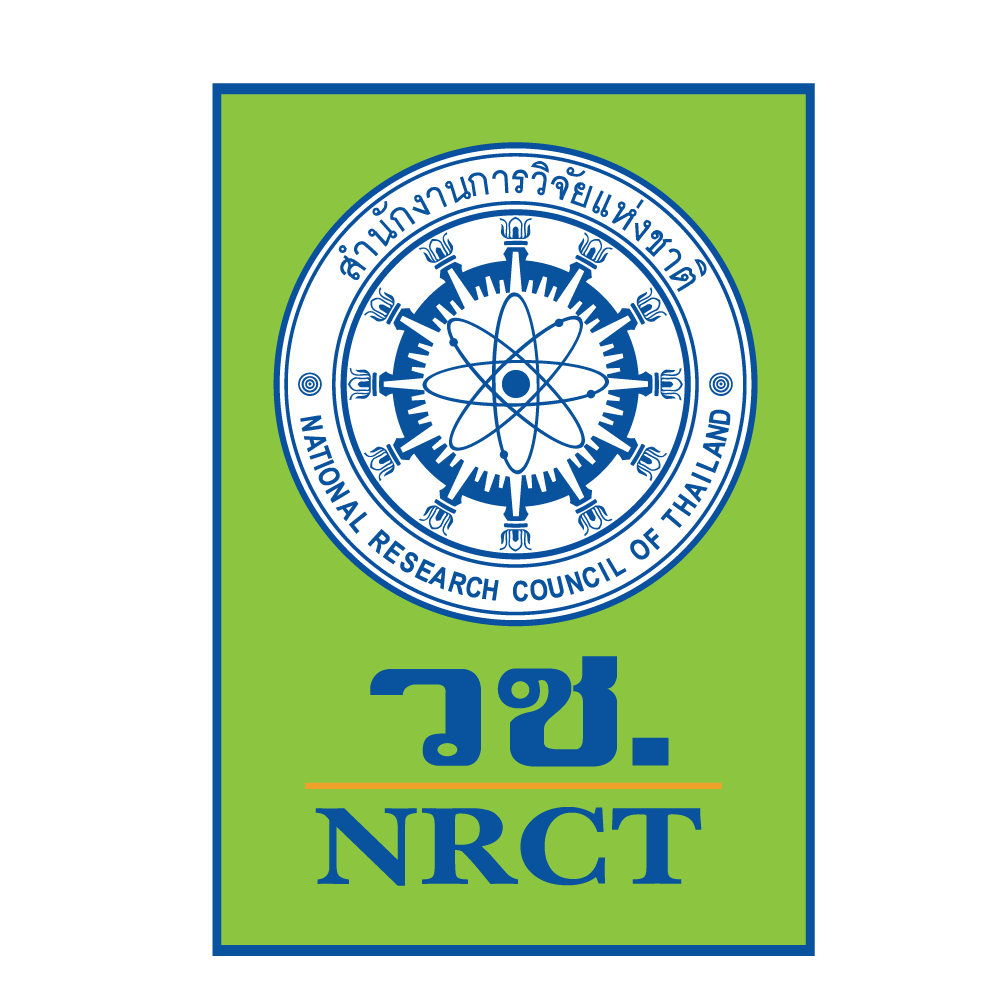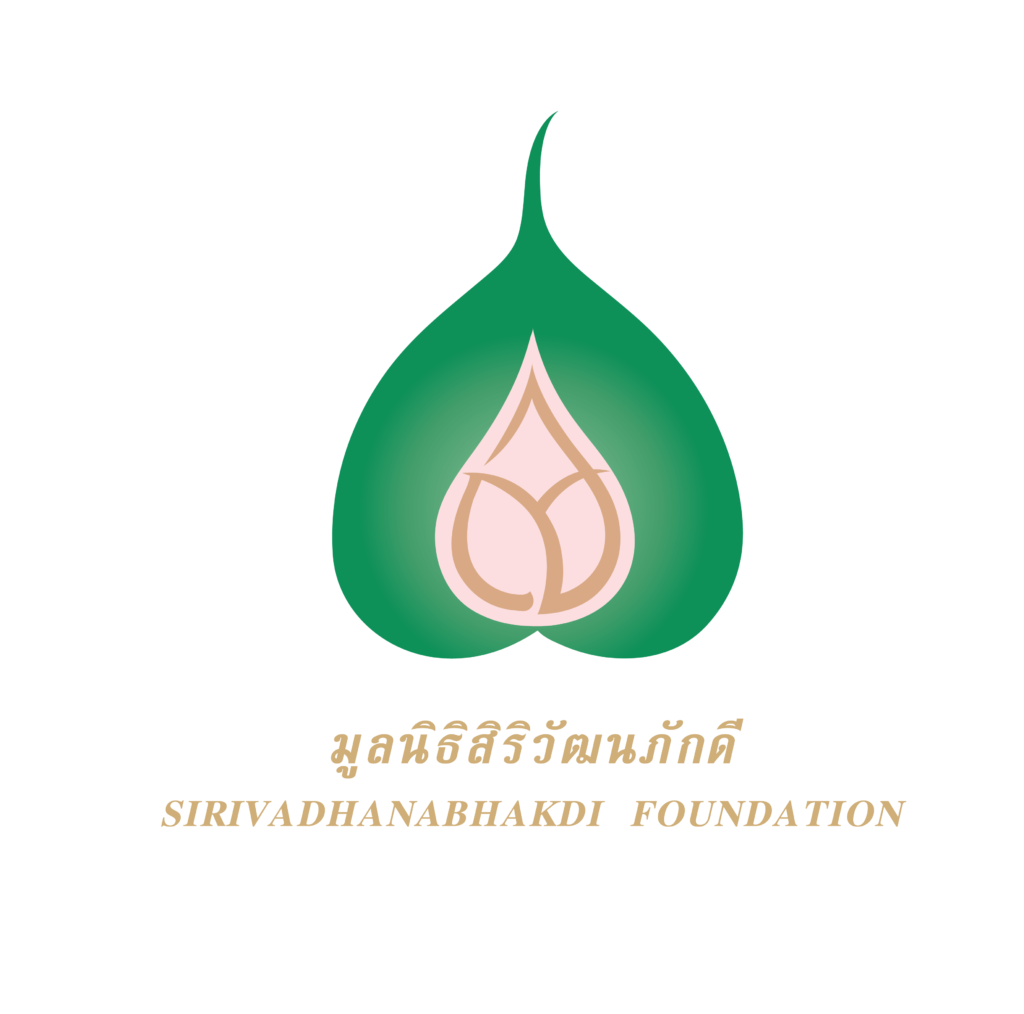Published in France in1854 AD, the Dictionarium Linguae Thai is the oldest published Thai dictionary. Its Thai contents, compiled by Jean-Baptiste Pallegoix during his first stay in Siam from 1828-1854 A, are translated into Latin, French, and English. Prior to its creation, aside from a Latin to Thai dictionary compiled as well by Pallegoix and printed by the Assumption publishing house in 1851, no work had yet been published.
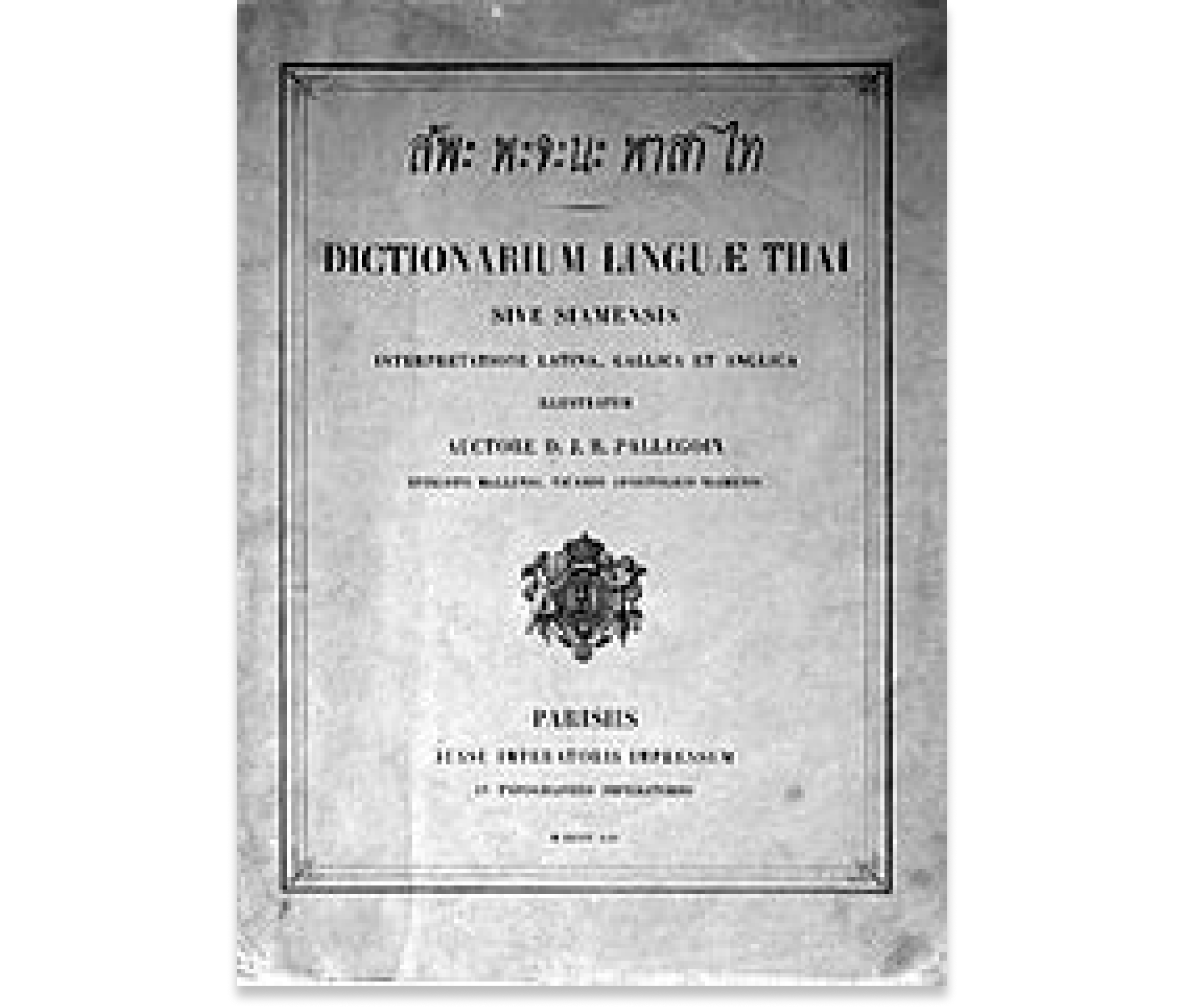

The Dictionarium Linguae Thai provides the era’s most complete compilation of Thai vocabulary. Works by Thai thinkers for use in reading and writing literature–such as the different versions of Chindamani as well as Kham Ritsadi, compiled by the Supreme Patriarch H.R.H. Prince Paramanujitajinorasa–contained only terms found in literary works and did not order entries alphabetically. Of the dictionaries compiled by non-Thais, the oldest is presumably the Thai to Latin and Latin to Thai dictionary of Louis Laneau, compiled during the reign of King Narai. However, no copies of this work survive. John Taylor Jones’ 1842 Thai to English dictionary contains no pronunciation guide for Thai words, only giving the Thai spelling and the English definition. Another Thai dictionary, compiled by J. Caswell and J. H. Chandler in 1846, includes the Thai term and its definition, also in Thai, but is not organized in alphabetical order or by category. Furthermore, it does not contain pronunciation information
Jean-Baptiste Pallegoix was born in the Combertault province of France on October 24, 1805. He first entered a seminary at 17 years old and then was ordained as a priest of the Foreign Mission on May 31, 1828.
Pallegoix left the Havre by ship on August 31, 1828 and arrived in Bangkok in mid-1830, during the reign of King Rama III, as a Roman Catholic missionary. Upon achieving sufficient Thai language proficiency, he became caretaker of the declining Catholic church in Ayutthaya as well as the Santa Cruz church in Thonburi where he oversaw the construction of a new church and performed its consecration on September 1, 1835. Later, he also oversaw the construction of the Conception Church and performed its consecration on May 24, 1837.
Pallegoix was appointed as Coadjutor Vicar Apostolic of Siam under Bishop Courvezy in 1835 and later, on June 3, 1836, as Vicar Apostolic of Siam. Following his consecration, Pallegoix immediately began construction of the Holy Rosary Church in Talat Noi. Following this, he restored and expanded the old publishing house, the benefits of which were experienced even within the Cochinchina diocese due the house’s use of Latin characters with tonal markers similar to those used within what is now Vietnam.
Pallegoix returned to France in 1853 alongside 2 Thais. There, he created a Thai-Latin-French-English dictionary as well as the book Description du Royaume Thai ou Siam. Following an audience with the Emperor Napoleon III and the Empress Eugenie de Montijo in 1855, he received approval to publish the dictionary in the royal publishing house. Pallegoix then returned to Siam carrying gifts from the Pope and the French Emperor to the Thai king. He died on June 18, 1862 in Bangkok.
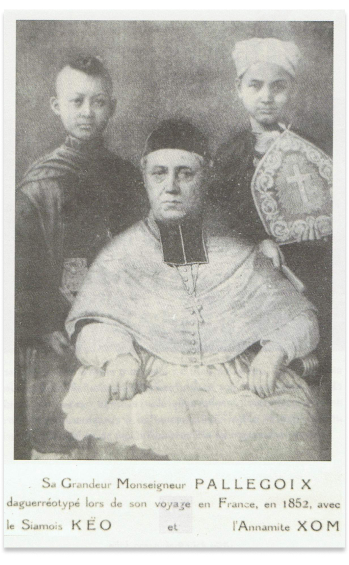
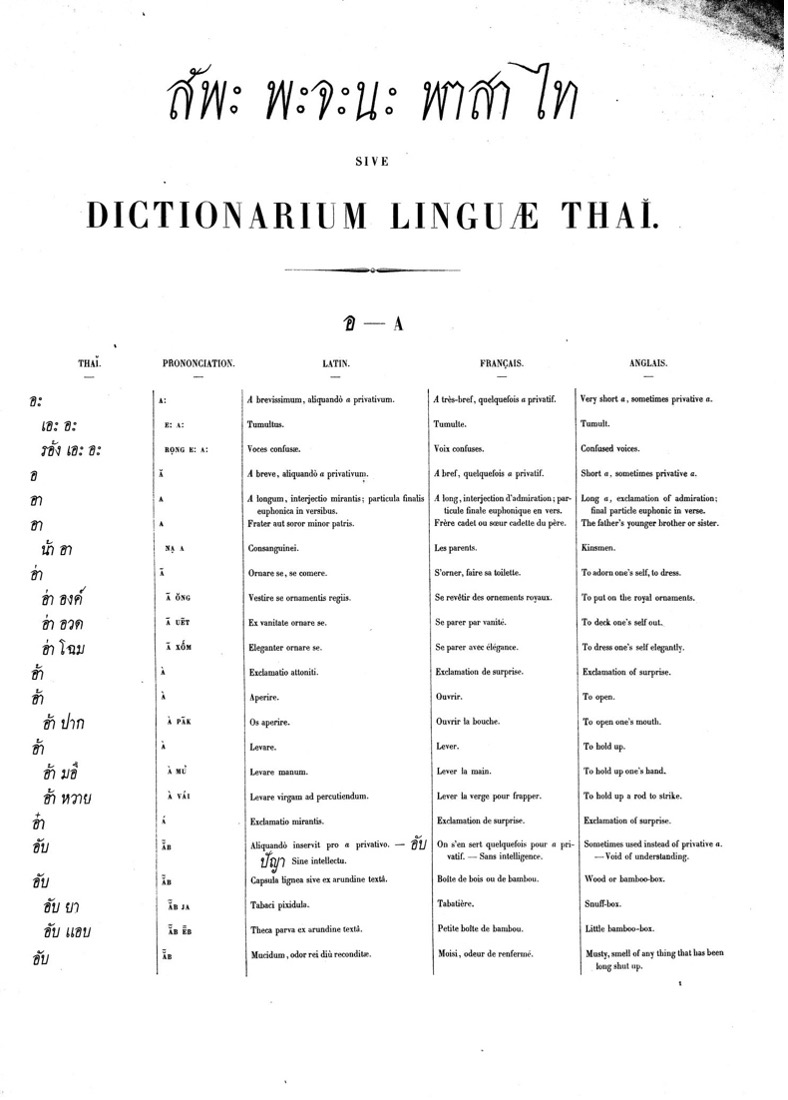
Dictionarium Linguae Thai is a four-language dictionary containing Thai entries alongside Latin, French, and English translations, which are arranged into 5 columns. Entries are ordered alphabetically from A to Z according to the Romanization of the Thai word. For each entry, the first column contains the Thai word; the second column contains the pronunciation guide; the third column contains the Latin translation; the fourth column contains the French translation, and the fifth column contains the English translation. In total, there are 29,276 Thai words, with 12,584 main entries and 16,692 sub-entries.
If an entry is a phrase, saying, or compound word, it is divided into its components. For example, อาบน้ำ is divided into อาบ น้ำ. However, words containing several syllables are given without separating the syllables, such as โฆษณา, อะดิเรก, ปสาวะ, etc. Each page contains roughly 30-35 main and sub-entries ordered alphabetically (A-Z) by the Romanization, with a systemized pronunciation guide. Therefore, a term beginning with the letter อ will come before one beginning with บ (B); จ (Ch); ด, ฎ (D); ช, ฉ, ฌ (X); etc.
The ordering of words in the dictionary, as such, has been done according to pronunciation. This may prove strange for typical users of Thai dictionaries. However, for linguists and those with knowledge of the Thai sound system and phonetic transcription, Pallegroix’s method if ordering words in the dictionary may, indeed, be rather interesting. In fact, it may be that he was the first linguist to systematically analyze the Thai sound system and its transcription according to their Romanizations.
Each Thai word is accompanied by a Romanized pronunciation guide similar to the transcription system used by Alexandre de Rhode for Vietnamese. Theraphan Luangthongkum (1991) provides the following guide to the pronunciation system used in the dictionary:
Tone symbols: Tone symbols may occur both above and below the vowel:
Mid tones are given with a symbol (i.e., ตา is written as TA and เท as THE)
Low tones are given with the symbol ‘ – ‘ (i.e., แตก is written as TË̄K, ไต่ is written as TẴI, and อ่วม is written as ŨEM)
Falling tones are given with the symbol ‘ ̀’ (i.e., เที่ยว is written as THÌAU, แต้ม is written as TË̀M, ไหว้ is written as VẰI, and ธูป is written as THÙB)
High tones are given with the symbol ‘ . ‘ (i.e., ช้า is written as XẠ, แร้ว is written as RẸ̈O, ท้าย is written as THẠI, ไว้ is written as VẶI)
Rising tones are given with the symbol ‘ ́ ‘ (i.e., ถอย is written as THÓI, ถอน is written as THÓN, ไหว is written as VẮI, โถ is written as THȎ́)
Consonant and vowel symbols: The consonant and vowel symbols used, aside from the letters A to Z, also include several diacritics. For example, a ‘ ̆ ‘ above a vowel indicates that the vowel is short. The symbol ‘ ̑ ‘ above the vowel ‘O’ indicates the Thai vowel โ, and the symbol ‘ ̈ ’above ‘E’ signals the Thai vowel แ.
Vowel symbols
Pallegoix’s symbol | IPA Symbols | Thai Vowel Symbols | Example Words |
I: | iʔ | -ิ | ติ |
Ĭ | i | -ิ | กิน |
I | iː | -ี | ปี, ปีน |
E: | eʔ | เ-ะ | เตะ |
Ĕ | e | เ-็ | เต็ม |
E | eː | เ- | เก, เลน |
Ë | ɛʔ | แ-ะ | แกะ |
Ë̆ | ɛ | แ-็ | แข็ง |
Ë | ɛː | แ- | แก, แกง |
Ư: | ɯʔ | -ึ | อึ |
Ŭ: | ɯ | -ึ | ตึง |
Ư | ɯː | -ื | มือ, กลืน |
Ơ: | ɤʔ | เ-อะ | เลอะ |
Ơ̆ | ɤ | เ-ิ-็ | เปิ่น |
Ơ | ɤː | เ-อ, เ-ิ | เรอ, เดิน |
A: | aʔ | -ะ | กะ |
Ă | a | -ั | กัด |
A | aː | -า | กา, กาง |
U: | uʔ | -ุ | กุ |
Ŭ | u | -ุ | ลุง |
U | uː | -ู | สู, สูง |
Ȏ: | oʔ | โ-ะ | โปะ |
Ȏ̆: | o | โ-็ | ปน, ตก |
Ȏ | oː | โ- | โน, โนน |
O: | ɔʔ | เ-าะ | เกาะ |
Ŏ | ɔ | -็อ | ร่อน |
O | ɔː | -อ | รอ, ร้อน |
IA | ia | เ-ีย | เปีย |
IE | ia | เ-ีย | เตียง |
IAU | iaw | เ-ียว | เรียว |
UˈA | ɯa | เ-ือ | เรือ, เครื่อง |
UE, UÒ | ɯa | เ-ือ | เดือน, เลื่อม |
UAI | ɯaj | เ-ือย | เลื่อย |
UA | ua | -ัว | ตัว |
UE | ua | -ว | มวน |
UAI | uaj | -วย | มวย |
AI | aj | ไ- | ไก, ไน |
AI | aːj | -าย | กาย |
ĂO | aw | เ-า | เกา |
AO | aːw | -าว | กาว |
EO | ew | เ-ว | เลว |
ȎI | oj | โ-ย | โรย |
OI | ɔj | -อย | รอย |
IU | iw | -ิว | ริ้ว |
ËO | ɛw | แ-ว | แร้ว |
ƠI | əi | เ-ย | เลย |
UI | ui | -ุย | ลุย |
Consonant symbols
Pallegoix’s symbol | IPA Symbol | Thai Consonant (รูปพยัญชนะ) | Example Word |
P | p | ป | ปา |
T | t | ต, ฏ | ตา |
CH | c | จ | จ่า |
K | k | ก | กา |
PH | ph | พ, ภ, ผ | พา |
TH | th | ท, ธ, ฒ, ถ, ฐ | ทา |
X | ch | ช, ฌ, ค | ชา |
KH | kh | ข, ฃ, ค, ฅ, ฆ | ขา |
B | b | บ | บ่า |
D | d | ด | ด่า |
M | m | ม | มา |
N | n | น, ณ | นา |
NG | n | ง | งา |
F | f | ฟ, ฝ | ฟ้า |
S | s | ซ, ศ, ษ, ส | ซา |
H | h | ฮ, ห | ฮา |
V | w | ว | วา |
L | l | ล, ฬ | ลา |
R | r | ร | รา |
J | s | ย | ยา |
Even though the main word for each entry is a Thai word written in Thai script, entries are not ordered according to the Thai alphabet as they would be in a typical Thai dictionary. To search a word in the Dictionarium, users must search according to the Romanization of the Thai word, A-Z, a system that emphasizes pronunciation. Therefore, a word beginning with อ will be in the ‘A’ section, while words such as เอ็น เอน and แอ่ง will be in the ‘E’ section, and words such as อ้อ โอ องค์ อ้อย and เอ่อ will be in the ‘O’ section.
As a brief guide, users of the dictionary may search words according to the following:
Within each letter group, the second letter further determines the order of the words. For example, within the group beginning with the letter ‘T’, those words beginning with the sound ตะ will take the letter ‘A’ as their second letter, as ‘A’ is used in place of -ะ -ั and -า. The vowels -ุ -ู -ึ and -ื are replaced by the letter ‘U’ and -ุ -ู -ึ and -ื are replaced by ‘Ư’.
Finally, the dictionary employs one more special feature: Users may see a particular word in a phrase or saying within the Latin column (3rd from the left), as shown below:
Term | Pronunciation | Latin | French | English |
กชาก | KAXAK | Vitrahere, hine et illinc trahere. – ฉวย กชาก เอาไป Vi eripere. – กชาก จาก มือ Eruere de minibus. | Emmener de force, trainer ça et là. – Enlever de force. – Arracher des mains. | To carry of by force, to drag about. – To take away forcibly. – To tear out of a person’s hands. |
Bibliography
L-Thongkum, Theraphan. (1991). Making of Thai-Thai dictionaries: Past to Present (1846-1990). Bangkok: Faculty of Arts, Chulalongkorn University.
Historical Archives, Archdiocese of Bangkok. (2015). Jean-Baptiste Pallegoix. Retrieved on 10 January 2022. Retrieved from https://catholichaab.com/main/index.php/2015-09-22-02-42-26/biography/2015-09-22-08-08-12/445-baptiste-pallegoix
